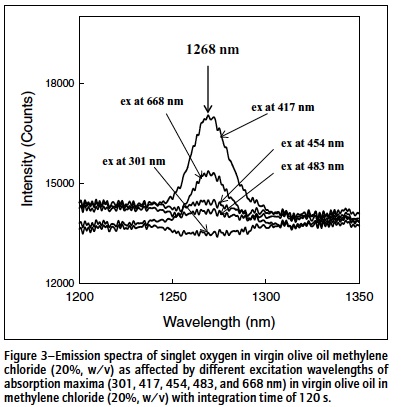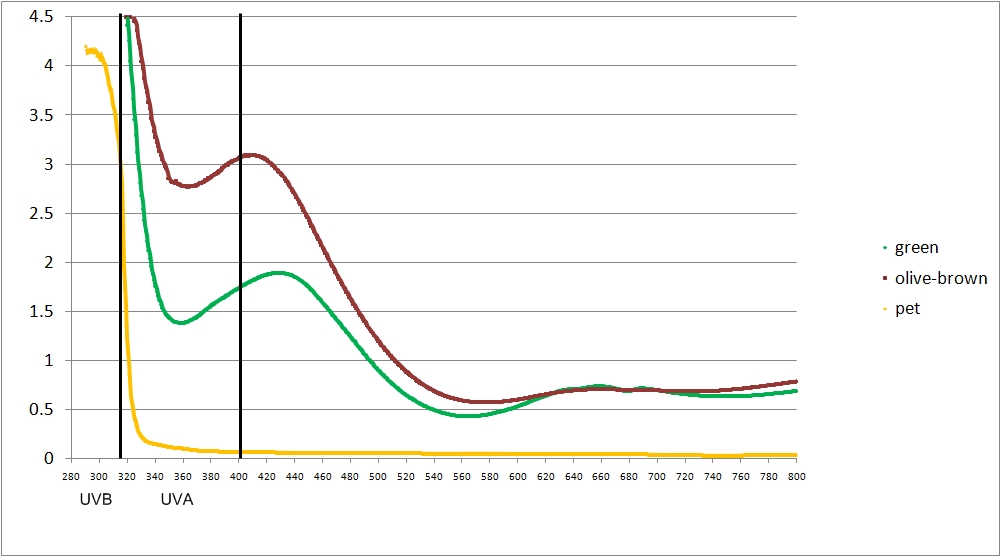I have seen a link posted a few times about a university study that compared various measures of quality for different brands of olive oils. Does anyone have that link?
Thanks,
Clark

Posted 23 March 2013 - 02:36 AM
Posted 23 March 2013 - 01:24 PM
Posted 23 March 2013 - 01:47 PM
Posted 23 March 2013 - 02:48 PM
Posted 23 March 2013 - 04:34 PM
The people who run AmphoraNueva know what they're doing, so you probably won't go wrong there.
Posted 24 March 2013 - 12:38 AM
Edited by tintinet, 24 March 2013 - 12:38 AM.
Posted 24 March 2013 - 12:43 AM
I'm cheap, so I use Kirkland Organic (see the UC Davis study) or Trader Joe's California Estate (see Consumer Reports testing.)
Posted 24 March 2013 - 01:03 AM
Posted 24 March 2013 - 11:04 AM
Here is a nice article that discusses the various grades of olive oils. The refined olive oils, have issues with oxidation, because they have been heated.
http://www.charlespo...tra_Virgin.aspx
Posted 24 March 2013 - 08:39 PM
Posted 24 March 2013 - 08:49 PM
I have now switched to this brand, after smelling it in the C60oo mixture that is being used for our LongeCity Mprize@home project. I had a good pungent olive oil smell. Still, I think it is imported, so I am not sure how the company knows if they are getting a top quality product.
Posted 25 March 2013 - 12:30 PM
Posted 26 March 2013 - 02:39 AM
Edited by motorcitykid, 26 March 2013 - 02:40 AM.
Posted 26 March 2013 - 07:31 AM
I wouldn't buy a brand sold in a clear bottle.
Edited by Adaptogen, 26 March 2013 - 07:34 AM.
Posted 26 March 2013 - 11:55 AM
I wouldn't buy a brand sold in a clear bottle.
I keep seeing this caution. Is there really that much degradation from fluorescent grocery store lights?
My most recent bottle of olive oil is unfiltered, in a clear bottle, but tastes many times more pungent/polyphenolic than any of the bertolli extra virgins ive gotten, which are sold in tinted bottles.
well, i do now see that all three bertolli olive oil samples failed the extra virgin test
Changes induced by UV radiation during virgin olive oil storage.
Even small doses of UV radiation induced oxidation of the virgin olive oil samples.
http://www.ncbi.nlm....pubmed/16787029
Edited by Turnbuckle, 26 March 2013 - 11:56 AM.
Posted 26 March 2013 - 06:10 PM
Posted 12 April 2013 - 08:27 PM
In contrast to the first UC Davis report of July 2010, which analyzed 52 samples of 14 brands, this report’s aim was to analyze fewer brands but more samples of each brand so as to improve the analysis of each brand. In addition, this study used two IOC-accredited sensory panels to conduct analysis based on the IOC sensory standards for extra virgin olive oil, in contrast to the July study, which used a single sensory panel to analyze samples.
The strongest relationship between chemical analysis and negative sensory results was found in the DAGs test (65 percent), followed by the PPP test (49 percent), UV K268 for conjugated trienes (34 percent), UV K232 for conjugated dienes (12 percent) and UV∆K (6 percent). The FFA, FAP and PV tests did not confirm negative sensory results. The IOC standards would be more effective in assessing and enforcing olive oil quality by including the DAGs and PPP standards
Posted 13 April 2013 - 02:41 AM
Posted 13 April 2013 - 10:40 AM
Posted 12 October 2013 - 01:39 PM
Looking at the chart [from the UC Davis 2010 olive oil bust] on Poliquin's site, I'm actually less worried about the health consequences of the EVOO fraud problem. The most likely reason for not qualifying as EVOO were flavor/taste/aroma issues, rather than objectively bad chemistry. There were a lot of cases where the diacylglycerols weren't quite high enough, but that's not a health issue, it's more just a characteristic of first press or something. It's not something that's particularly good or bad for you, so not having enough isn't a problem in itself. The PPP (pyropheophytin) values might represent a problem. They indicate that the oil has been heated, however, it doesn't correlate strongly with the oxidation measures K232 and K268, so the if the oil was heated, it was probably in the absence of oxygen. Some of the oils were oxidized, which is clearly a problem, and some had pretty low polyphenols, which mean that you're probably missing many of the health benefits, along with getting a boring tasting oil.
The best bet is probably to buy from olive oil experts like Veronica Foods/AmphoraNueva. I doubt they would steer you wrong. I wish they'd post the chemistry on all their oils, though.
Posted 17 December 2013 - 11:09 PM
The best bet is probably to buy from olive oil experts like Veronica Foods/AmphoraNueva. I doubt they would steer you wrong. I wish they'd post the chemistry on all their oils, though.
I am, as most of you will know, a huge fan of VF. They're quite transparent about chemistry: if the full chem on a given oil isn't listed on the AN website, call and ask — they'll give it to you. Occasionally, they will put an oil for sale before they have the full analysis back (heretofore DAGs and PPP, often oleic acid (not FFA), and some other specialized tests have been done in Australia, though they may begin doing more of them in CA with UCD opening up their labs for commercial testing), which increases lag time for these parameters; and, no one is perfect at updating websites.
Posted 17 December 2013 - 11:56 PM
Posted 18 December 2013 - 02:50 PM
My vote for best olive oil would have to go to a company called Castillo de Piñar. They offer an organic extra virgin olive oil that is harvested by hand, cold press-extracted within hours of harvest, and they bottle the oils in miron glass. Need I say more?
I use this and don't trust foreign olive oil http://www.californiaoliveranch.com/ http://www.businessi...oil-2012-1?op=1 http://www.npr.org/b...ive?ft=1&f=1003
Are there independent lab analyses available that confirm VF's olive oil chemistry claims?
Posted 18 December 2013 - 08:09 PM
... The use of Miron glass is actually a bad sign, since (a) mauve glass is actually likely one of the worst colors for olive oil storage containers, and (b) the fact that they would use it suggests that they may be engaged in other un- or counterproductive practices under the spell of woo.
The virgin olive oil in methylene chloride (20% w/v, oxygen saturated) was irradiated at the 301, 417, 454, 483, and 668 nm, then the emission at 1268 nm, singlet oxygen dimole decaying was observed. The result showed the highest production of (1)O(2) with light irradiation at 417 nm, and followed by at 668 nm in virgin olive oil, indicating that pheophytin a and chlorophyll a were the most responsible components for the production of singlet oxygen. The UV light irradiations at the wavelength of 200, 250, and 300 nm did not induce any detectable luminescence emission at 1268 nm, but 350 nm produced weak emission at 1269 nm. The quantity of (1)O(2) produced with excitation at 350 nm was about 1/6 of that of irradiation at 417 nm.
 41.jpg 166.28KB
9 downloads
41.jpg 166.28KB
9 downloadsEdited by hav, 18 December 2013 - 08:26 PM.
Posted 18 December 2013 - 08:59 PM
Are there independent lab analyses available that confirm VF's olive oil chemistry claims?
It depends on what you mean by "independent." All of their oils are sent away for testing at 'independent' labs, most usually Modern Olives (particularly for PPP and DAGs), and the results are prominently displayed in their client stores and at AmphoraNueva, with most stores maintaining binders with copies of the CoAs for inspection. However, one could of course say that this isn't 'independent' because VF is paying for it! This is a tricky thing to get around, as someone has to pay for the analysis. VF has not been included in an attempt at independent audit-testing like Consumer Reports, Choice, or even the UC Davis study (which, as critics like to point out, was funded by the Califonia Olive Oil Association). While there have been a couple of disputed and very small attempts (3E and the Extra Virgin Alliance), there is no real equivalent in the olive oil industry to Consumer Labs or the USDA organic seal (which, of course, retain some conflict of interest problems built into their structure) aside from the Int'l Olive Commission and North American Olive Oil Association, who reward and prop up mediocre oil with a low-bar, early-testing pass/fail system with no disclosure, instead of supporting real quality or transparency.
Posted 18 December 2013 - 09:33 PM
... The use of Miron glass is actually a bad sign, since (a) mauve glass is actually likely one of the worst colors for olive oil storage containers, and (b) the fact that they would use it suggests that they may be engaged in other un- or counterproductive practices under the spell of woo.
This study suggests that only UV filtering at 417 and 668 nm may be relevant in choosing glass by color for olive oil:
Luminescence spectroscopic observation of singlet oxygen formation in extra virgin olive oil as affected by irradiation light wavelengthsthe highest production of (1)O(2) with light irradiation at 417 nm, and followed by at 668 nm in virgin olive oil ... UV light irradiations at the wavelength of 200, 250, and 300 nm did not induce any detectable luminescence emission at 1268 nm, but 350 nm produced weak emission at 1269 nm. ...
Miron violet glass might not be optimal, but it looks like its not bad. Transmission at 417 nm is somewhere between 0-10% while it blocks everything at 668 nm:
41.jpg 166.28KB 9 downloads


All [VF] oils are sent away for testing at 'independent' labs, most usually Modern Olives (particularly for PPP and DAGs), and the results are prominently displayed in their client stores and at AmphoraNueva, with most stores maintaining binders with copies of the CoAs for inspection.
CoAs are a start.
I wasn't able to locate them at VF's or AN's website though. Can VF/AN provide CoAs via email?
Posted 18 December 2013 - 10:24 PM
CoAs are a start.
To be clear, having started, they're about 100 miles ahead of the competition. Try asking almost any company out there even to tell you what their chemistry is, let alone to see a copy of a CoA ...
I wasn't able to locate them at VF's or AN's website though. Can VF/AN provide CoAs via email?
No: they're somewhat paranoid about giving out physical or electronic copies for fear of fraudulent use. Again, their own and most of their client stores have them available on-site in binders for inspection.
0 members, 0 guests, 0 anonymous users